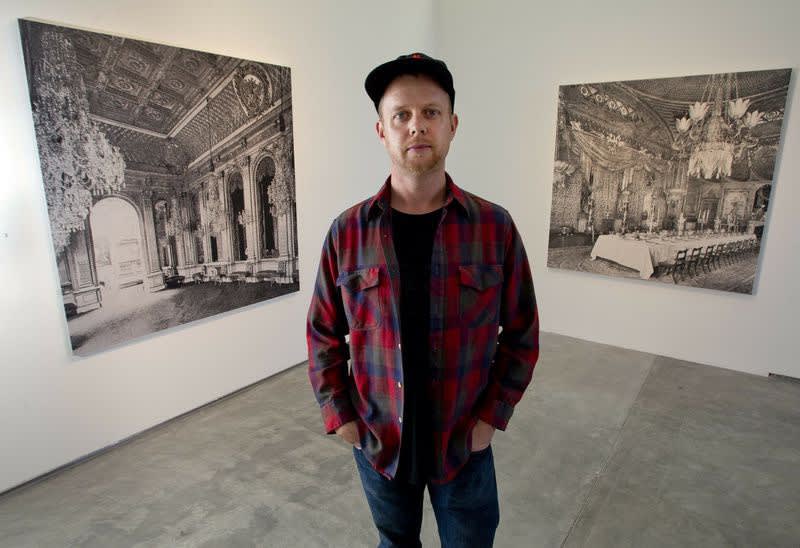Like much of the population, artist James Chronister grabs a cup of coffee and goes into work.
But what Chronister does when he gets there makes him unique.
Guided by a halftone picture projected onto a canvas, he paints little black dots, replicating the tiny dots comprising the original image.
He’ll do hundreds, even thousands of little dots every day. When he’s finished one small section of the painting, he’ll move the canvas over and do another. And after a month of more of painting those dots, he has an image, most commonly of a forest scene or a palace interior.
It’s a reproduction, but not exactly.
“It sort of takes the middle man out of the process,” said Chronister, who is going to work at the Lux Art Institute, where he is in residence through April 13. “Instead of looking at something, trying to remember it, and then painting it, I just took me out of the equation and made it into busy work.”
Connecting the dots
We perceive much of the world, of course, through dots. Computer screens, video monitors, digital cameras, newspaper photographs, magazine advertisements — all are comprised of thousands of tiny dots that trick our eye into seeing a continuous image. The higher the density of the dots, the more easily we are fooled.
In halftone printing, which was developed more than a century ago, you can almost see the dots with the naked eye. And when the print is enlarged and projected onto a canvas, the dots are even easier to see. All Chronister has to do is reproduce them by hand, and over a period of time he creates a picture of the picture.
The telling thing, however, about Chronister’s work is that it’s impossible to remove the middle man.
No matter how meticulously Chronister executes his images — and he’s remarkably meticulous — some element of imperfection inevitably creeps in. And it’s that subtle imperfection that draws you into his strangely evocative art.
“If I really wanted to make this awesome (meaning, perfect), I’d screen print it,” said Chronister. But painstakingly painting them by hand day after day is the only way to make sure there’s a ghost in the machine, and it turns out to be Chronister.
“They are handmade, so they don’t quite work,” he said. “They waver a little bit. Maybe the paint was too thick here, and too loose here. Maybe I just mixed it differently, by accident, and I didn’t know until I was done.
“So there are these shifts within the painting itself. They are kind of about humanity; they are about a person making these things and trying their best to make it certain way. But it’s never going to be perfect.”
Musical aspirations
Chronister, who attended the University of Montana and the California College of the Arts in San Francisco, where he now lives, didn’t exactly come across his process by accident. But he didn’t plan it, either.
“I made paintings that looked like that, photo realist paintings, working with an image in one hand, a brush in the other,” he said. “And just through trial and error, I discovered this technique.”
A musician who played in bands as a teenager and continues to play bass in the San Francisco band NeoLance, Chronister compares his art to an analog recording made on a vinyl record. All the clicks, pops and imperfections are evident, but the outcome somehow transcends the process (and yet is dependent on the process at the same time).
At Lux, he’s working on another palace interior, an image through which he intends to evoke a certain state (perhaps isolation, or decay and loss?). He finds the same quality in the forest scenes he says were likely inspired by a youth spend wandering in the Montana woods, listening to music, and playing Dungeons and Dragons.
“My friend described listening to the new My Bloody Valentine album, and he said, as he was listening through the headphones, he felt like the music created this actual space right in front of him ...
“I thought that was completely accurate. The space that music creates, it’s a mental space. It’s this mental space you can walk into and walk out of. And it has different moods and feelings. It’s up and it’s down and it’s left and it’s right.
“That’s what I’m trying to get across in my paintings.”
You can find that space in his work at Lux, just beyond those dots.


